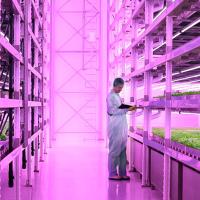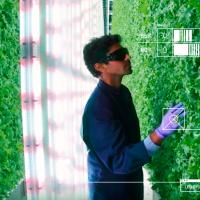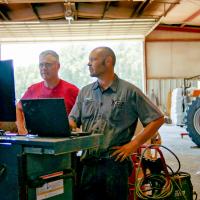Instead of shipping food all around the world, imagine a farm in a shipping container. Nature in a box — self-contained, solar powered, using a fraction of the water and space of a traditional farm.
It’s automated, sending data to your smartphone, and the key component … are fish.
That’s the vision of FarmPod, a St. Croix-based startup looking to improve food availability using automation and a vertical farming method called aquaponics.
“Large-scale agriculture has pesticides, uses a huge amount of fossil fuels, and is really rough on the planet,” Mike Straight, creator and CEO of FarmPod, tells Freethink.
By using automation software to make their pods’ aquaponics system as easy to run as possible, Straight wants to provide a healthy, localized source of food with minimal labor and carbon footprint.
Which brings us back to those fish.
What is Aquaponics?
Aquaponics combines the farming of fish in tanks — aquaculture — and growing plants outside of soil using just water, known as hydroponics.
When it’s working right, aquaponic systems can produce both high quality plants and fish, quickly and efficiently.
Think of an aquaponics system like a loop. Inside a tank of water, fish or other aquatic creatures — like shrimp — are raised. The waste that they produce is turned into nutrients by bacteria inside the water, and that nutrient-rich water is then pumped to the plants, providing a natural, renewable, and localized source of fertilizer.
Among the most commonly grown fish in aquaponics are tilapia: their combination of size, rapid growth, and dense populations makes them ideally suited to the tanks. Hybrid striped bass, perch, catfish, trout, and crayfish also grow well in aquaponic systems.
The aquatic animals are fed with surface-floating food that provides them with all the nutrition they need. The fish take their protein-rich food, break it down, and poop out into the water two different ammonia products (one of which can poison the fish if it reaches too high a level).
When the amount of ammonia in the water reaches a critical mass, microbes in the water metabolize it into nitrogen, a process called nitrification. This nitrogen-fertilized water is then pumped through the plant medium, and the plants pull out these super-charged nutrients to grow.
According to Iowa State extension fisheries and aquaculture specialist Allen Pattillo, aquaponics can significantly reduce the time it takes to grow crops. Butterhead lettuce can be grown using an aquaponic system in 30 days — half as long as it requires using conventional methods, Pattillo writes.
The end result is essentially a pond ecosystem in a box. Fish feed and excrete fertilizer; that fertilizer-rich water is used to grow the plants; and the water is then recycled back down to the fish, the feeding of which is the only outside intervention. (And can be done, in the case of FarmPod, automatically.)
Advantages of Aquaponics
Because it is a closed system that recycles its water and does not require outside synthetic fertilizer — the creation of which typically requires a lot of fossil fuels — aquaponics is considered more environmentally friendly and sustainable than traditional agriculture.
Aquaponic systems require far less land and water than conventional crop raising.
Its ability to grow both plants and fish rapidly and in any conditions may also provide strong economic benefits — you could grow out-of-season produce year-round, for example, taking advantage of higher off-season prices.
The waste products of the plants and aquatic animals can also be converted to fertilizer and sold as well, or the water can be used to irrigate crops beyond the aquaponic system.
Optimizing Aquaponics
Primary drawbacks of aquaponics include startup costs, the relative complexity of an aquaponics system, and the electricity needed to ensure that the pumps are always running.
To address these concerns, FarmPod has turned to essentially shipping a farm in a box. Each pod, which takes up roughly one parking spots’ worth of space, arrives with everything inside of its small shipping container base, including the sensors, tanks, and materials needed to build the greenhouse section above the fish. It is designed to be able to be built by two people in two days.
Once the FarmPod flywheel is in motion, that sensor suite powers an automated system. The system performs the daily tasks aquaponics requires, including checking water pH levels, feeding the fish, and figuring out the amount of dissolved solids in the water and adjusting the feeding accordingly.
“So with aquaponics, the automation is really helpful because it takes a long time to develop a feel for it,” Beecher Cotton, chief engineering officer of FarmPod, tells Freethink. The goal, Cotton says, is to get FarmPod to do all of that for you.
“A product like this has to be simple to operate,” founder and CEO Straight says. “And if it’s not simple to operate, it’ll never get it done.”
Straight estimates a FarmPod can be run on about five hours a week of labor, and the startup says it can produce over 100 pounds of fresh produce a week.
Lettuce, tomatoes, strawberries, kale, and collard greens can all be grown aquaponically, along with a myriad of other plants. And in addition to tilapia and catfish, FarmPod can provide an aquaponic home for crayfish, barramundi, koi, perch, and freshwater prawns.
Powering this automated system are a suite of solar panels, which allow FarmPod to operate without any kind of electrical grid, and draw its power without any carbon emissions.
One Pod at a Time
By shrinking aquaponic systems down to a meager footprint and optimizing the most difficult and labor intensive tasks involved in it, FarmPod hopes to bring the technique to people beyond urban farms.
“We’re trying to feed the world one pod at a time by hyper-localizing farming, and taking the farm and putting it right in front of the place that needs to use it,” Straight says.
We’d love to hear from you! If you have a comment about this article or if you have a tip for a future Freethink story, please email us at [email protected].


